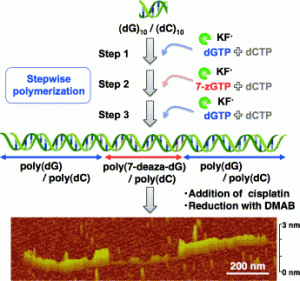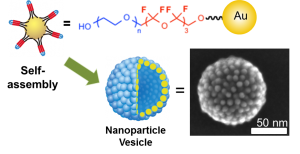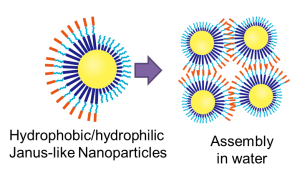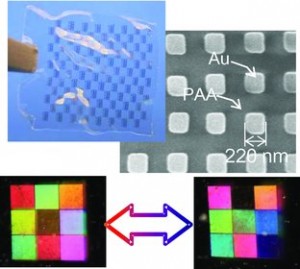Research Overview
All bioorganisms are composed of biomolecules, such as proteins, nucleic acids, lipids and sugars. They perform efficient energy transfer, selective synthesis of biomolecules, and interactive information processing through the formation of highly organized supramolecular complexes based on molecular recognition and self-assembly.
On the other hand, nanotechnology, which is a generic term for the manipulation techniques of materials on a nanoscale, has been developed by researchers, and engineers and novel features have emerged from the study of small materials on a nanoscale.
We have focused on the functional features of biomolecules and nanotechnology, in particular metal nanoparticles, and have studiedthe fabrication of molecular devices and functional materials by the combination of these components through two different approaches.
One approach is the “development of nanodevices using biomolecules “. This refers to the application of biomolecules to nanotechnology. We aim at the fabrication of functional molecular devices by using biomolecules themselves (proteins, nucleic acids, lipids, sugars) or their features such as molecular recognition and self-assembly.
Another approach is the “development of biodevices using metal nanoparticles”. This refers to the use of nanomaterials for biological applications. We aim at the development of useful devices in the various biological fields; e.g., drug delivery carriers, through the control of the size, shape, and surface properties of functional nanoparticles (the particles themselves or assemblies).
-2-1024x768.jpg)
Research Topics
Development of Nanodevices using Biomolecules
Enzymatic Synthesis of a DNA Triblock Copolymer that is Composed of Natural and Unnatural Nucleotides
DNA molecules have come under the spotlight as potential templates for the fabrication of nanoscale products, such as molecular-scale electronic or photonic devices. In this study, we developed an enhanced approach for the synthesis of oligoblock copolymer-type DNA by using the Klenow fragment exonuclease minus of E. coli DNA polymerase I (KF−) in a multi-step reaction with natural and unnatural nucleotides. AFM images showed that this DNA block copolymer could be sequence-selectively metalized. This approach could expand the utility of DNA as a template.
Development of drug delivery carriers based on nanomaterials to pass biological barriers
The efficient delivery of drugs into target cells or organs is required to obtain maximum drug action without side effects. To transport drugs to the target sites, drug carriers need to pass various biological barriers. We are focused on the use of virus-like particles and nanoparticles to pass biological barriers, such as the plasma membrane and nucleus pores. Our two main approaches are as follow; (1) the chemical encapsulation of drugs (including enzymes and RNAs) into the virus-like particles that allow stimulus-responsive release, and (2) the surface and shape engineering of inorganic nanoparticles to promote the cellular uptake and transport of drugs into the cytosol or nucleus after passage through barriers such as the plasma membrane and nuclear pores toward therapeutic applications.
Development of Biodevices using Metal Nanoparticles
Assembly of metal nanoparticles for optical and biomedical devices
Assembled structures of noble or metal nanoparticles produce different optical, magnetic and electronic properties from those of individual nanoparticles. Therefore, assembled structures of metal nanoparticles have been expected to aid in the development of new devices. Our group is exploring the self-assembly approach of functional nanoparticles from the view point of surface chemistry to make new assembled structures.
Fabrication of tunable photonic or plasmonic devices using hydrogel
Nanotechnology has allowed the development of various micro- or nano-fabrication techniques. Now we are able to build fine structures on solid substrates. However, we are not yet able to tune these structures dynamically. To resolve this issue, we focused on the use of hydrogel. One specific feature of gels is that the swollen state can be modulated through environmental changes including pH, ionic strength, temperature and so on. This allows dynamic control of the gel expansion and contraction and leads to many applications of the gels as stimuli-responsive soft matter. It is expected that the fabrication of nanostructures on the hydrogel will enable dynamic control of the array structure, leading to functional applications. Therefore, we have developed a novel method for the fabrication of metal nanopatterns on the hydrogels through transfer from a solid substrate. Gold nano-dotted pattern prepared by Electron Beam lithography showed structural colors as photonic crystals and these colors could be modulated by controlling the nano-dot spacing through change in the swollen state of the gels.





